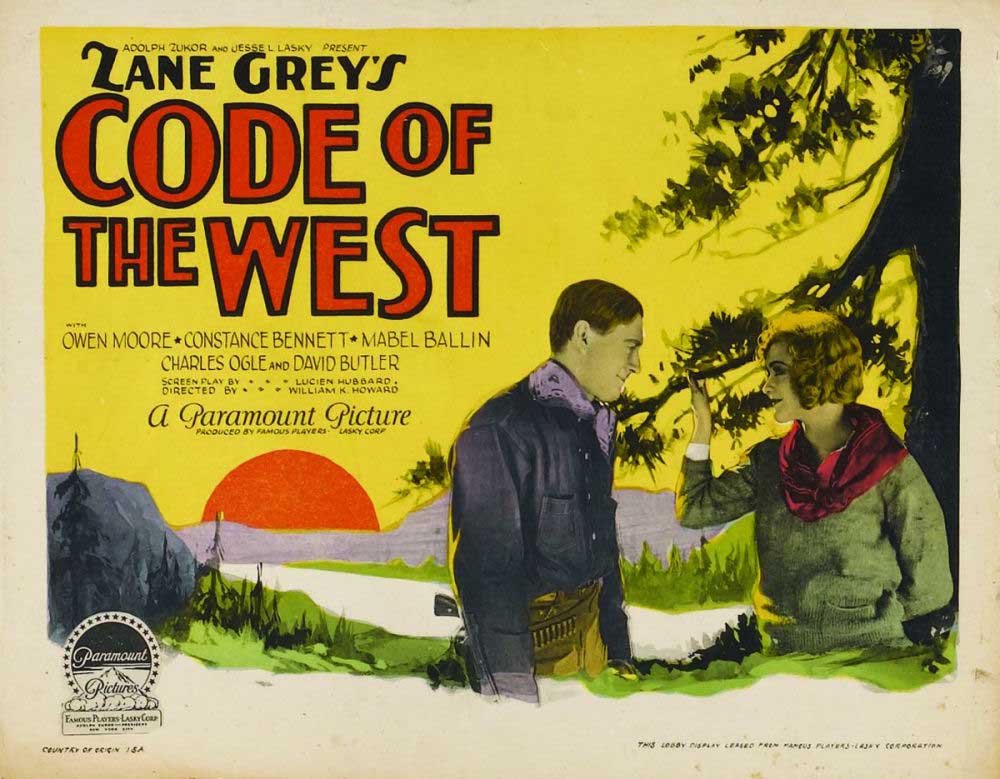Editor’s Notebook: Rural life and ‘Code of the West’
Published 4:00 pm Thursday, January 23, 2014

- <p>An old theater lobby card advertises "The Code of the West," the 1925 movie version of author Zane Grey's novel of the same name. Some Westerners are looking to the principles embodied in "The Code of the West" for guidance on how to succeed and get along today.</p>
The Code of the West sounds like a book by cowboy author Zane Grey and it is but its a lot more, including a useful way of getting people today to think about the realities of rural life.
Theres a vast region of America where we live because great-grandmas covered-wagon axle broke here or grandpa found work in a logging camp the next valley over. This shared past also still governs how we live today. Whether they know it or not, plenty of people descend from homesteaders who built lives from scratch, but werent averse to calling for help getting across a flooded creek or raising a barn. It stands to reason that ideas like independence, self-sufficiency and neighborliness go hand in hand.
Of course, homesteading also meant settlers were the recipients of some big gifts from fellow citizens usually at least 320 acres of land, plus a school for your kids, and a sheriff to lock up Crazy Pete the Prospector when he got too drunk on Saturday nights. But still, in comparison with lots of other places, people mostly did for themselves.
Growing up the son of a six-gun-toting Zane Grey disciple, I learned (approximately in chronological order) to: always know what youre shooting at, walk, talk but not too much, read everything, be respectful to everybody, stand up to bullies, dont hesitate to get your hands dirty when thats what the job requires, learn from your mistakes, build good fences, know who your friends are and always be ready to make new ones, do favors without expecting thanks, pay your bills on time, find work you love, dont hold grudges, and never mix whiskey and wine. As for the birds and the bees we were too bashful about the whole topic to ever discuss it. Well into my teens, I kind of suspected kissing girls led to babies in some mysterious way. Little did I know
In practicality, the code mostly came down to being honest, minding your own business and being willing to tow neighbors pickups out of snowdrifts regardless of their political or religious peculiarities.
The Oregon House of Representatives went so far as to endorse its own brief and idealistic version of the code in 2011 on a 44-14 vote. Some dissenters noted that Old West values once included a heck of a lot of racism and sexism. Perhaps the House should have added learn from your mistakes. Not everything that was once right remains so forever.
More usefully, some rural counties have in effect made a pragmatic version of the code into their own official zoning and lifestyle guidelines. See, for example, Siskiyou County, Calif., which issued a guide for residents (bit.ly/CodeOfWest) with items like:
Fundamental to the theme of The Code of the West is this concept: the right to be rural. Although self-reliance is required, rural neighbors need each other. A horse or two may live next door and there are wild animals living in the woods. Clean water, sanitation and access are your responsibility.
Another example: Dont move next to a commercial forest and complain when the time comes to cut it or when logging trucks come down the road. The same can be said in our area about logging operations and fish-processing businesses. One persons nuisance is anothers traditional way of making sure their kids have decent lives.
The outer coastline of Oregon and Washington remains a remarkable outpost of the personal and environmental values that made the Pacific Northwest a worldwide legend. Beauty and creativity thrive here on an epic scale. Boy, are we lucky. But spend a little time perusing the updated satellite-photo mosaics on Google Earth and youll witness just how massively things have changed here in the past 20 years. Forests are being carved up into smaller pieces, land near beaches is filling up with houses. The ample spaces we once enjoyed to avoid rubbing each other in the wrong ways are going away.
We must have an ongoing discussion about our own version of The Code of the West. Heritage, hospitality and hipness can go hand in hand.
On a closing note, as Valentines Day rushes toward us like Pepé Le Pew in the old Looney Tunes cartoons, its a proper time to remember that brides used to pledge to be bonny and buxom in bed and at board.
Dating from about 1,000 years ago when words had different meanings, this vow isnt as racy as it sounds, sadly interpreting into something rather bland like I promise to be nice and to make things you like for dinner. But its a safe bet that knowing smiles were exchanged along with the words.
Bonny and buxom in the sense of being nice to one another is still a good principle to live by.
M.S.W.
Matt Winters is editor of the Chinook Observer and Coast River Business Journal.




